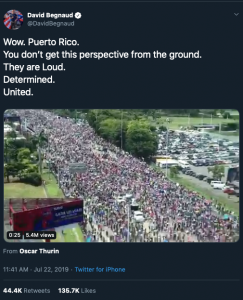On July 13th, 2019 the Center for Investigative Journalism (Centro de Periodismo Investigativo) published 889 pages of leaked Telegram chat logs between the then-governor of Puerto Rico, Ricardo Roselló Nevares, and members of his cabinet. The chat logs contained misgoninistic and homophobic comments as well as corruption schemes. “Don’t we have a cadaver to feed our crows?” wrote a high ranking member of the government in the chat, in reference to the deaths caused by Hurricane María, which struck the island in 2018. It is estimated that 4,600 people died as a result of the hurricane.
As an immediate result of the leaked chats, Puerto Ricans collectively called for the governor’s resignation, a call that was tagged as #RickyRenuncia on social media. After two weeks of massive protests, on July 24th, 2019, Ricardo Rosselló announced his resignation on the official government Facebook page.
#RickyRenuncia
✊✊✊🇵🇷
Esto fué hermoso ❤ pic.twitter.com/9eAN9CVy84— Maldo5ht (@maldo5ht) July 25, 2019
The RickyRenuncia Project seeks to preserve digital materials (video, audio, images, news, tweets, amongst others) related to the governor’s resignation. In this interview, Marisol Ramos, Latin American and Iberian Studies Librarian at the University of California, Santa Barbara, Joel Blanco Rivera, professor at the Escuela Nacional de Conservación, Restauración y Museografía in Mexico City, and Irmarie Fraticelli Rodríguez, graduate student in Information Science at the University of Michigan, met with Archivistas en Espanglish to talk about how they tasked themselves with compiling physical and digital materials related to the protest and the importance of documenting events like these through non-traditional methods.
(Archivistas en Espanglish) How did this project and collaboration come about?

Tweet most widely shared during the protests.
(Joel) The project started in the midst of the protests. Marisol posted on Facebook asking if anyone was documenting what was happening. So, I replied because as soon as the protests started I began to collect tweets with the #RickyRenuncia hashtag. From there, it was organic, the conversations began and shortly thereafter Irmarie was integrated into the group.
(Irmarie) Everything was spontaneous. It was all done through comments and conversations on Facebook. From my end, I got the idea of collecting protest signs while at the massive protest at the Luis A. Ferré Highway. People were discarding them because it was raining and they were soaked. Marisol put me in touch with Fernando Acosta, an archivist at the Princeton Library Digital Latin American Archive of Ephemera, where they focus on collecting Puerto Rican materials and so the signs were of great interest to them.
(JBR) So, Irmarie had the protest signs and I was working on Twitter and that’s where the idea to collect web materias, especially news articles, came from. Then I heard that the Internet Archive has a collection called “Spontaneous Events Collection”, which allows groups to build their collections without having to pay a subscription to Archive-It. So we sent the Internet Archive a proposal via email and the next day they had accepted it. Our responsibility was to select the resources that were going to make up a part of the collection and work on metadata. The team at the Internet Archive took care of all the technical aspects.
(AE) Could you talk about your own experiences during the summer of 2019 and how those personal experiences shaped the project, the content curation, access pathways, etc?
(MR) Those of us who live outside of Puerto Rico have witnessed what is happening in Puerto Rico and we also witness what is happening to Puerto Ricans in the diaspora. In the United States, Puerto Ricans were connecting with each other and organizing marches. That touched us. This wasn’t just a thing happening on a little island in the Caribbean. The internet and social media have expanded who views themselves as being part of the boricua identity. I have a friend in Estonia and he would photograph events, being the only Puerto Rican there, he would post them on Facebook and talk about how he felt there and how he wanted to be part of the protests in Puerto Rico, given that he had been involved in the Vieques protests. That was more or less what resonated with me and it made me think about things that we should discuss more often.
(JBR) My experience is similar to Marisol’s, but being in Mexico. On a personal level, I felt solidarity but also nostalgia. I don’t know if nostalgia is the correct word, but I felt I wanted to be there as a Puerto Rican but also as an archivist. That’s why I’ve focused on archiving tweets. I had a dataset of tweets relating to the 2017 University of Puerto Rico strike. During that semester, Irmarie was my student and at that time I was working with my students on archiving tweets using Scalar, and working on themes surrounding the fiscal crisis and budgetary cuts affecting the University. So, when the Rosselló leak happened, I had the interest to continue to collect tweets. Also as an archivist, I know that we can’t wait a year to start compiling materials on social media–mainly because of the technology. But that also can lead to a process where you are just accumulating and that is not what we wanted to do. It was more of a process of selection.
(IFR) At that moment I was on the island and I would have never thought I was going to end up doing archival work because I saw myself as a person in the protests. I too was angry. I too wanted to go to La Fortaleza [governor’s mansion] to protest and I also brought my own protest signs. It wasn’t until I saw what Marisol was posting on Facebook that I realized that I also hold the knowledge to document these events and that I had to use that knowledge. I remember that on that same massive protest, I had asked my sister: “Should I grab the signs? Would you all do that with me?”. And so we all ended up collecting signs while it rained. At that moment, I didn’t use a lot of selection criteria because I knew that I had to approach people, that I had to be quick, and that I had to recognize that others were angry as well. So I took advantage of the situation and picked up signs that people were discarding while quickly interviewing protestors. I could only ask their name and why they were there. I collected 7 audio files of people reading their banners and it’s interesting that you can hear the anger in their voices.
(AE) Why did you decide to start archiving web pages and tweets to document this particular moment in history?

Posters from the protests as they dried. “A low-cost improvised process!”, noted Irmarie humorously.
(MR) One of the reasons is that we wanted to show that Puerto Rico is part of social movements far larger than the island itself. What happened last summer is not an isolated event but a larger response that adopted strategies and social movements happening at a global scale. If you look at what was being shared on social media, you see the merging of feminist, anti-capitalist, anti-corruption, anti-racist, and LGBTQ movements, among others. Communication was happening online by large and there were differences between what was showing up in the media and what was actually happening on the streets. That is why we emphasized on amplifying a variety of perspectives that were not necessarily covered by the main news outlets who instead craft a narrative and control how the story will be represented. Suddenly you have an emphasis on certain celebrities and themes like Ricky Martin, Bad Bunny, el Rey Charlie, and “perreo combativo” and it’s awesome but there were other things happening and other groups of people participating as well. That is why we emphasize the digital. And with their ephemeral quality, not many archives in Puerto Rico nor the US have the flexibility or capacity to preserve this type of medium. Meanwhile, we have worked on this subject for years. We felt that we could push back on existing standards and barriers that exist within web and social media archiving. If we don’t break from tradition, thousands of stories will disappear.
(JBR) Part of what has been documented is only one representation of how the protests took place, particularly the use of social media as the main means of communication. It’s important to point out the fact that social media is ephemeral as is the fact that protests were also happening outside of the capital city of San Juan. The island’s main news outlets prioritized what was taking place in San Juan, specifically Old San Juan. The reality of course is that protests took place all over Puerto Rico and in the United States as well. In our web collection we not only bring focus to the main newspapers in Puerto Rico but also show how regional newspapers covered what was taking place. It was important that we identify these news items as another way of documenting what took place. There will always be an official archive that tells a particular story, but other perspectives of what happened also exist and we believe they are equally as important to preserve and share.
(MR) It is also worth mentioning that the signs used for the protests were created for single use and not intended for preservation purposes. If Irmarie had not been there, aside from other archivists and librarians also doing this work, we would hardly have a record of this aspect of the protests. Even then they only represent a fraction of all the posters created during this period, their only other record is via the photographs of the protests taken by individuals who were present. This is why the physical aspect of collecting is important even if what is left behind is the ephemeral.
(IFR) It was crucial to gather memes. Many of the calls to action in relation to the protests were carried out through memes. These are also images that people create for one day and then they seem to disappear. These announcements show the multiplicity of sectors within our society here and outside the island who participated either as individuals or as organizations. Compiling these digital elements help us reflect on the multiple communities that were part of all the events that took place last summer. Even though it’s said that it was one voice, the reality is that many diverse entities joined on to the protest. And that is of great historical value, to recognize the diversity in the individuals, organizations, and communities that took to the streets.
(MR) Dance and music were used as a tool of resistance and protest. Those moments are also ephemeral, spontaneous, and truly the only evidence that they in fact took place is the video footage that people uploaded on social media. Another good example are the “cacerolazos”. It’s really interesting how people, for example, in New York City would take out their pots and record videos of themselves to be in solidarity with the people in Puerto Rico. There is an element of performance in this type of protest that most often is not captured by the media. That is why we want to call on people to donate their digital artifacts; to truly represent the diversity in voices that would have never joined had it not been for the leaked chats.
(JBR) We also compiled newspapers from other countries. And in the same case as the posters, they only show a fraction of the people who were actually present at the protests. It’s important to reiterate that the RickyRenuncia archive is not meant to be the absolute and sole archive of these protests, which is why we want to emphasize the concept of representation and recognize the limitations, silences, and gaps of the archive.
(AE) The collection will form part of the Internet Archive’s Spontaneous Event Collections. How do you define the word “spontaneous” in this particular context? Do you consider this to be a spontaneous event?
(MR) It’s a conversation that we have had since the beginning of this process. First there is the fact that it’s the word that the Internet Archive uses to describe events like the Black Lives Matter movement and the Arab Spring. The word “spontaneous” is disputed and honestly I am not quite not sure it ‘s the correct one. There are moments that yes, are spontaneous. Like putting a call to action on Facebook or Twitter and it’s at that point that suddenly everyone shows up. What is not spontaneous are the organizations that not only came together last summer but have been protesting for many years, since La Junta [PROMESA], since Hurricane Maria, and since the many other disasters that took place beforehand. It’s spontaneous only in the sense that a sole group did not actually organize everything in advance. There is a difference between that and all the grassroot organizations that had already been organizing and used the chat to galvanize and bring attention to what has been going on in the country for years. That is why it’s a historical event, it surpassed past massive protests such as those around Vieques, la Telefónica, or the workers’ strikes. Those were events that had specific roots within an issue but the leaked chats cut across ideologies and groups because we can all say that we’ve lost someone before or after María due to a lack of response or accountability by the Puerto Rican and United States government. Any human being sees dead people being made fun of…and that will serve as a catalyst.
(JBR) That is a good question for the Internet Archive. But yes, totally in agreement. It ‘s important to make note that this was not only about everyone getting angry about a leaked chat. The chat was the straw that broke the camel’s back.
(MR) Spontaneity also comes from the fact that our project initially comes about from a Facebook post. We as humans have this impulse to organize information and a way to do it is by cataloguing and tagging. Perhaps we should consider another label more appropriate for these types of events.
(IFR) To a certain degree, I had thought about it as the act of us three coming together that week to meet and document as a team. First it was Marisol’s post, then my idea of gathering posters while at the protests on the highway as it rained. I think that also reflects the spontaneous nature of this project. It was also spontaneous how the rest of the programmers and designers joined the team. So perhaps the word spontaneous refers more to us as a team rather than the actual event itself. We were just awarded an IMLS grant and that was quite spontaneous as well.
(MR) Just like the person who takes a photograph which then suddenly becomes viral. The spontaneous is the connection that we are forming through technology that twenty years ago was not available. We no longer are in the realm of professional photographers who are the only ones capable of taking a good photo. Now we are all citizens with the same ability to document, to archive, and to demand justice. It is on us to preserve our own histories, we cannot depend on institutions. If these collections are not part of their collecting mission, especially in the case of minority and marginalized communities, we simply don’t exist. Sometimes it is best to collect records and from there search for the institution or organization that not only has the necessary resources but that truly cares and understands where you are coming from. We are trying to facilitate this. Serving as intermediaries is a way to carry on the archival activism to which we are committed.
Click here to read the second part of the interview.
Featured image: Most popular hashtags, extracted using TWARC.
Interview by Cristina Fontánez Rodríguez, Yvette Ramírez and Caroline Gil.




